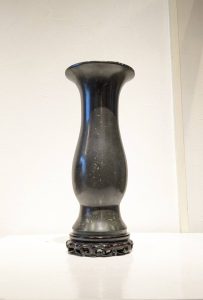軽くて便利、エコにも(愛知県名古屋市千種区姫池通 骨董買取 古美術風光舎)
2024.06.27
皆さまこんにちは。スタッフTでございます。
梅雨入りといいつつ、あまり雨が降らない日が続いていますね。この梅雨の合間の晴れは「梅雨晴れ」「五月晴れ」「梅雨晴間」など色々な表現がありますが、梅雨らしくジメジメ感もあり蒸し焼きにされそうな体感です。

今日は風がありますが、暑い日にすれ違う多くの方々の手には小型扇風機が。流行るようになったのは2017年頃。なぜ流行りだしたのかというと、実はK-POPアイドルの影響であると言われています。 K-POPアイドルが使用し始め、それを見たアイドル好きの女の子たちが持ち出したのではないかと言われています。現在では、幅広い年齢層の方が使用しており、 今では日本で持ってても違和感のない存在となりました。
大流行した時に、もちろん私も乗っかって購入したのですが、若者と同じように使う自分に少々恥ずかしさも感じ、結局出かける時の荷物になって邪魔になり、扇子に戻ることになりました。
普段からなぜか重いカバンを持ち歩く私には、軽い扇子の方が持ち運びも場所も取らず便利でした。後付けですがエコですしね(笑)
サッと開くと、美しい柄や艶やかな質感の紙が姿を現し、閉じると、凛とした佇まいが目をひく扇子。平安時代に誕生し、今もなお伝統芸能やお茶の席、日常使いなど、さまざまな場面で重宝されています。日本が誇る伝統的工芸品のひとつでもありますね。
扇子の歴史は古く、平安時代初期(紀元8世紀頃)にまで遡ります。
当時貴重だった紙の代わりに、記録用紙として用いられていた「木簡(もっかん)」を重ねたもので、2〜3cm幅の薄い木の板を重ねて作られました。主に桧(ヒノキ)材が使われていたことから「桧扇(ひおうぎ)」と呼ばれました。形状が洗練され、その後、扇面にはさまざまな絵柄が描かれるようになり、宮中に仕える女性たちの間で広まりました。
京都・東寺(とうじ)の千手観音像の腕の中から発見された、「元慶元年(877年)」と記された桧扇が現存する最古の扇だとされています。
初期の檜扇は男性貴族が公の場で略式の笏(しゃく=束帯を着用するとき右手に持つ細長い薄板)として使用されるようになり、宮中での複雑な作法を書き留めておくためのメモ帳としても使われていたと言われています。やがて檜扇の装飾性が高まり、要も紙縒(こより)から木釘へ変わり、装飾された金具で補強されるようになります。木簡を綴じていた紐もより装飾性に工夫が凝らされるようになりました。
扇面に絵が描かれるようになると装飾品として宮中の女性にも普及します。女性の持つ檜扇は袙扇(あこめおうぎ)と呼ばれ、装飾品としてだけではなく、とっさに他人の視線を遮る道具としても用いられていました。
こうして檜扇は平安時代に貴族の正装の必需品となり、あおぐという本来の役割だけでなく、礼儀や贈答、コミュニケーションの道具としても用いられるようになりました。
扇面に和歌を書いて贈ったり、花を載せて贈ったりしたことが、源氏物語や蜻蛉日記など多くの文学作品や歴史書に書かれています。
檜扇に続いて登場したのが『蝙蝠扇(かわほりおうぎ)』です。これは片面に紙を張り付けた紙扇ですが、いつ誕生したのかについては定かではありません。蝙蝠扇の名称は、広げた形が蝙蝠に似ている、あるいは「紙貼り」の音が変化したことが由来とされています。
あおいで「涼」を取るという、現在の一般的な使用法がポピュラーになったのは、庶民文化が花開く江戸時代後期頃。「涼」を取る小道具としては他にうちわがありますが、うちわのオリジナルは中国ですが、扇子のオリジナルは日本なのですよ。
扇子はコンパクトさと大人の上品さを兼ね備えた素敵なアイテム。調べていくうちに他にも気になることが・・・続きはまたの機会に。
ではでは、また。
Hello everyone. This is Staff T.
The rainy season has begun, but the days without much rain are continuing. There are many ways to describe the sunny days in between the rainy season, such as “the clear skies of the rainy season,” “the May sunshine,” and “the clear skies of the rainy season,” but it feels as if we are being steamed and roasted with the dampness of the rainy season.
There is a breeze today, but many people I pass on this hot day have small fans in their hands. It was around 2017 that they became popular. As to why they became popular, it is said that it is actually due to the influence of K-Pop idols. It is said that K-pop idols started using them and girls who saw them and liked idols brought them out. Today, they are used by people of all ages and are now a common sight in Japan.
When they were all the rage, of course I got on board and bought one, but I felt a little embarrassed at myself for using it in the same way as the young people, and eventually it became a burden in my luggage when I went out and got in the way, so I had to go back to using a fan.
For some reason, I usually carry a heavy bag, so a lightweight fan was more convenient to carry and took up less space. It’s an afterthought, but it’s also eco-friendly (lol).
When opened quickly, a fan reveals beautifully patterned and glossy paper, and when closed, its dignified appearance is eye-catching. Originating in the Heian period (794-1185), fans are still valued in a variety of settings, including traditional performing arts, tea ceremonies, and daily use. It is one of the traditional crafts that Japan is proud of.
The history of the fan is long, dating back to the early Heian period (around the 8th century A.D.).
Instead of paper, which was precious at the time, fans were made by layering “mokkan,” thin wooden boards 2 to 3 cm wide, which were used as recording paper. It was called a “hiwogi” because it was mainly made of cypress wood. The shape was refined, and later various designs were painted on the surface of the fan, which became popular among women in the court service.
The oldest surviving fan is said to be a cypress fan inscribed with the date “Genkei 1 (877)” that was found in the arm of a statue of the Thousand-Armed Kannon at Toji Temple in Kyoto.
In the early days, hinoki fans were used by male aristocrats as a scepter (a long, thin sheet held in the right hand when wearing a sokutai) for official occasions, and they were also used as notepads for writing down complicated court etiquette. Eventually, the hinoki fan became more decorative, and the main part of the fan changed from paper twine to wooden nails, and it was reinforced with decorated metal fittings. The strings used to bind the wooden fan also became more decorative.
When pictures were drawn on the surface of the fan, it became popular among court ladies as a decorative item. The hinoki fans held by women were called nebu-fan (worn by women but worn by men), and were used not only as ornaments but also as tools for shielding one’s eyes from the gaze of others in an emergency.
Thus, the hinoki fan became a necessity for the aristocrats’ formal wear during the Heian period (794-1185), and was used not only for its original role as a fan, but also as a tool for courtesy, gift-giving, and communication.
The use of fans for writing waka poems or placing flowers on them as gifts is written in many literary works and historical books, such as The Tale of Genji and the Dragonfly Diary.
Following the hinoki fan, the “kawahori-ogi” (bat fan) appeared. This is a paper fan with one side covered with paper, but it is not known when it was created. The name “kawahori-ogi” is said to have originated from its shape resembling a bat or from a change in the sound of the word “kawahoshi” (paper fan).
The current common use of fans to keep cool became popular in the late Edo period (1603-1868), when the culture of the common people was flourishing. The original fan is Chinese, but the original fan is Japanese.
The fan is a wonderful item that is both compact and elegant for adults. As I researched, I found something else that caught my attention… I’ll continue the story another time.
See you soon.
Translated with DeepL.com (free version)
*******************
ご実家の整理やお片付けなどをされている方のご相談などが多くございます。
お片付けなどくれぐれもご無理のないようになさってくださいませ。
風光舎では古美術品や骨董品の他にも絵画や宝石、趣味のお品など様々なジャンルのものを買受しております。
お片付けをされていて、こういうものでもいいのかしらと迷われているものでも、どうぞお気軽にご相談下さいませ。
また風光舎は、出張買取も強化しております。ご近所はもちろん、愛知県内、岐阜県、三重県その他の県へも出張いたします。
まずは、お電話お待ちしております。
愛知県名古屋市千種区姫池通
骨董 買取【古美術 風光舎 名古屋店】
TEL052(734)8444
10:00-18:00 OPEN

